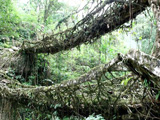|
|
TODAY.AZ / Weird / Interesting
The living bridges of India
16 December 2010 [12:45] - TODAY.AZ
 Some of the greatest engineering feats ever accomplished date back to the ancient world. The enigmatic pyramids can certainly make their point, but so can these incredible bridges of northeastern India depicted below.
Some of the greatest engineering feats ever accomplished date back to the ancient world. The enigmatic pyramids can certainly make their point, but so can these incredible bridges of northeastern India depicted below.It is estimated that planning for these bridges took 10-15 years in many cases, and because they grown out of living tree roots, they are considered the most sustainable foot bridges in the world.
These structures are extremely robust, reach up to 100 feet in length and date back more than five centuries. Perhaps the most amazing aspect about these bridges is the fact that in their own particular way, they are alive.
They require the harvesting of a few betel nuts to create and the credit for their development goes to a tribe in the hilly Khasi and Jaintia region of India, which is considered one of the wettest places on Earth.
“The War-Khasis, a tribe in Meghalaya, long ago noticed this tree and saw in its powerful roots an opportunity to easily cross the area’s many rivers. Now, whenever and wherever the need arises, they simply grow their bridges,” claims the Atlas Obscura.
The Khasis had their own root-guidance system, which they developed by slicing the betel nut trunks down the middle and hollowing them. This would force the thin, amenable roots of the rubber tree to grow straight out. When they reached the other side of the river, they would take root in the soil of the bank. The living bridge over time was thus created.
These bridges are unbelievably strong and are known to support as many as 50 people crossing at one time. At one point, the villagers wanted to modernize and tear the bridges down and build steel ones. A nearby resort owner talked them out of it.
/Weird Asia News/
URL: http://www.today.az/news/interesting/78269.html
 Print version
Print version
Views: 1874
Connect with us. Get latest news and updates.
See Also
- 06 December 2024 [22:20]
Are scented candles harmful to health? - 23 November 2024 [14:11]
Magnitude 4.5 earthquake hits Azerbaijan's Lachin - 20 November 2024 [23:30]
Launch vehicle with prototype of Starship made its sixth test flight - 27 October 2024 [09:00]
Fuel prices expected to rise in Sweden - 24 October 2024 [19:14]
Turkiye strikes terror targets in Iraq and Syria - 23 October 2024 [23:46]
Kazakhstan supplied almost entire volume of oil planned for 2024 to Germany in 9 months - 23 October 2024 [22:17]
Taiwan reported passage of Chinese Navy aircraft carrier near island - 23 October 2024 [21:50]
Russia remains largest oil supplier to India - 16 October 2024 [17:54]
Gamesummit co-founder shares insights on future of gaming industry in Azerbaijan [EXCLUSIVE] - 12 October 2024 [18:27]
TikTok cuts jobs, turns to AI for content moderation
Most Popular
 Human rights in Armenian and the PACE farce
Human rights in Armenian and the PACE farce
 UNESCO celebrates 950th anniversary of Diwan Lughat al-Turk
UNESCO celebrates 950th anniversary of Diwan Lughat al-Turk
 Azerbaijan's FM meets with Secretary of Holy See for Relations with States and International Organizations
Azerbaijan's FM meets with Secretary of Holy See for Relations with States and International Organizations
 Azerbaijani Foreign Ministry congratulates Kingdom of Bahrain on national holiday
Azerbaijani Foreign Ministry congratulates Kingdom of Bahrain on national holiday
 Azerbaijan's Ministry of Emergency Situations marks 19th Anniversary
Azerbaijan's Ministry of Emergency Situations marks 19th Anniversary
 Decottigny is more of a salad than a diplomat
Decottigny is more of a salad than a diplomat
 First VP Mehriban Aliyeva shares footage of President Recep Tayyip Erdogan singing Sari Gelin
First VP Mehriban Aliyeva shares footage of President Recep Tayyip Erdogan singing Sari Gelin
